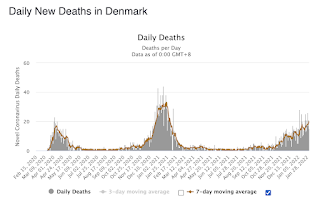At the beginning of the year, I argued that the epidemiological situation warrants lifting all restrictions by the end of January.
This is for 2 reasons
(1) Omicron is mild, and doesn't kill
(2) Omicron is unstoppable, making restrictions pointless.
Denmark is an example of a country following my advice. Restrictions have been lifted, despite infections being at all times high and deaths pretty high as well.
For a country of 5 million people, Denmark is counting about 40 000 infections a day and 1.7 million positives overall, most of them during the latest Omicron days. As not all infections are documented and not all people test or choose to declare a home test, this means that the number of infected people is likely not far from the total Danish population. The virus obviously does the same thing everywhere. The Danes are just better at testing.
What do these numbers mean? Well, let's assume people live about 30 000 days (think of a round number a bit under 100 years x 365 days/year). A death occurring within a month of a positive test is generally counted as a COVID-19 death, regardless of other conditions. If 30 000 randomly chosen people are diagnosed today, one of them is expected dead by the end of the day and one more every day forever. Thus, a virus running at 30 000 positives a day should be running at 30 daily deaths without even doing anything as an infection.
If we look at the Danish data, Omicron has 40 000 cases and only about 20 deaths. Thus, it seems to be doing about nothing if not less than nothing.This is strange, as any illness, no matter how mild, is expected to kill some people. The people who are supposed to die next month, should die now if they catch a cold or Omicron. Strangely, this is not what we see in the Danish data. Omicron seems to cause no deaths at all.
This is even stranger, as you expect dead people to be more frequently tested than live ones and, thus, undetected Omicron infections to be more frequent among the living than among the dead.
Sure, Denmark has a population which is well educated, well vaccinated (80% vaccinated, 60% boosted) and a good health care system.
In countries without a good medical system, you expect
-- fewer tests
-- more deaths, vaccinations are low and unvaccinated are more likely to die
-- a higher death ratio, as having fewer tests makes it more likely to miss infections in healthy people than in the dead or dying,
This we see, for example, in India where Omicron appears to infect a relatively small fraction of the population, like Delta appears to have done. This seems impossible, as the wave is going down. The only plausible mechanism is that most people are infected and therefore immune. Next wave will come when the virus mutates enough to evade immunity (antigenic drift).
Running at 100 000 cases, if the virus does nothing, we should see roughly 100 deaths a day. In India, we see about 1000, as, unlike Denmark, a lot of cases go undetected. This is not because the virus is more deadly in India: It isn't. It is most likely, less deadly, due to India's young population and poor medical system (e.g., weak people are long dead, and don't wait for COVID-19 as they do in western countries).
Conclusion: Like I said at the beginning of the year, Omicron's high transmission rate signals the end of the pandemic. We should have a restrictionless spring and summer! I am so looking forward to it.
I note that like most boring educated people, who want to travel from time to time, I am vaccinated and boosted, as are my mother and sister.
References:https://www.dw.com/en/covid-digest-denmark-lifts-almost-all-restrictions/a-60618361
https://www.bbc.com/news/world-europe-60215200
https://edition.cnn.com/2022/02/01/europe/denmark-lifts-covid-restrictions-intl/index.html




No comments:
Post a Comment